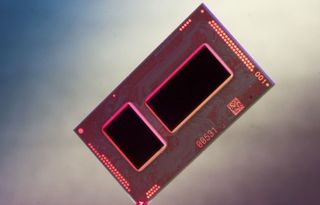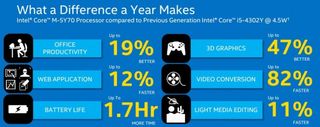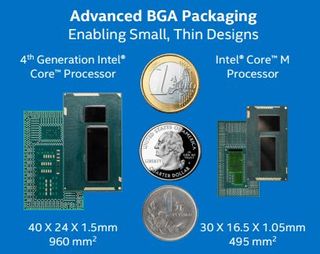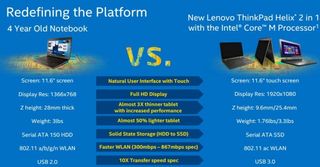Intel's New Core M CPU: Everything You Need to Know

Things are finally heating up for Intel's cool-running processor, with Apple utilizing a 1.1 and 1.3GHz dual-core versions in its latest, and first fanless, MacBook. Intel company first announced its Core M CPU at Computex Taipei in June, providing few details but touting the platform's ability to power a new generation of fanless tablets and 2-in-1 laptops. Manufacturers such as Lenovo and Dell have announced products based on Core M.

The first CPU based on Intel's next-generation, 14nm Broadwell architecture, Core M operates at a TDP (Thermal Design Power) of just 4.5 watts, which compares very favorably to the previous "Haswell" notebook CPUs, which have TDPs ranging from 11.5 watts for a low-end Core i5 or Celeron to 57 watts for a quad-core, Core i7. Having lower TDP means not only longer battery life, but less heat to dissipate. With Core M, the TDP is low enough that hardware vendors can use passive cooling methods instead of fans.

Going fanless allows manufacturers to build thinner devices that make less noise. For example, the latest MacBook half an inch thick; the second-generation Lenovo ThinkPad Helix is just .38 inches thick, compared to its .46-inch, Core i5-powered predecessor. Where the original Helix's keyboard dock had a hinge with dual fans built-in, the new Ultrabook Keyboard has not even one fan. Last year's model lasted just 5 hours and 48 minutes when detached from its dock, but the Lenovo promises 8 hours of endurance from the Core M-powered Helix.
MORE: Best Laptops
To be fair, the Core M isn't designed to replace Intel's regular Core Series, which includes the Core i3, Core i5 and Core i7 CPU families, nor does it eliminate the need for the company's low-cost, low-power Atom CPUs. The new platform sits in-between Atom and Core Series processors in terms of price, power and performance, offering faster speeds than the Atom Z3700 series that powers many budget tablets, but slower marks than a typical Core i3 or Core i5 processor.
Compared to last year's Haswell Y processor, which powered pricey, fanless tablets like the $1,099 Sony VAIO Tap 11, Core M promises 1.7 hours of additional batter life, 82 percent faster video conversion and 47 percent better 3D Graphics, according to Intel's internal tests.

Though Core M is the first processor based on Intel's new 14nm Broadwell architecture, it certainly won't be the last. In 2015, Intel plans to use Broadwell as the basis of its next-generation Core i3 / i5 / i7 chips for both laptops and desktops. Over the past few years, Intel has released a new processor architecture on an annual basis, with a die shrink occurring every other generation. The current Haswell and prior-gen Ivy Bridge architecture use a 22nm process while Broadwell will be the first to use 14nm.
Stay in the know with Laptop Mag
Get our in-depth reviews, helpful tips, great deals, and the biggest news stories delivered to your inbox.
A smaller die size means that Intel can fit more transistors into a smaller space, using less power, generating less heat and taking up less space in the chassis. The Core M processor package eats up just 495 square millimeters of space, about half the size of the 960 square-millimeter 4th Generation Core Series package.

At least at first, Intel will be selling three SKUs of the Intel Core M. The Core M-5Y10 and 5Y10a both run at a base frequency of 800-MHz with the ability to turbo up to 2-GHz. The Core M-SY70 has a base frequency of 1.1-GHz with the ability to reach 2.6-GHz if needed, along with Intel vPro technology for adding security and manageability. All three SKUs feature Intel HD Graphics 5300 chips and have two cores with the ability run four threads at once.

With Core M, Intel is not primarily targeting early adopters with expensive tastes (althoughThe new MacBook starts at $1,299). Representatives told us that the company's goal is to convince consumers with older laptops that now is the right time to upgrade. According to Intel's data, there are over 600 million PCs that are more than 4 years old. To some extent, Intel and Microsoft are victims of their own success. A 4-year-old laptop still performs most tasks competently and runs Windows 7, which remains more popular than Windows 8.1 and its unfamiliar Modern UI.

However, an older laptop is probably not as thin and light as a Core M-powered system and it's unlikely to be a 2-in-1. Even if they haven't considered replacing their laptops, consumers may be interested in buying large tablets. Intel believes it can sway potential iPad and 10-inch Android slate buyers with Core M hybrids that serve as both laptops and tablets.
However, the average laptop selling price is under $500 and most standalone tablets start at under $500. The first two Core M systems, the ThinkPad Helix and Dell Latitude 7000, are both made for business and priced at $999 or higher. If Intel hopes to bring Core M to the masses, it will need its OEM partners to provide more aggressive pricing.
With the new MacBook coming on April 10, we'll see if this efficient chip provides enough power to justify the laptop's cost.

